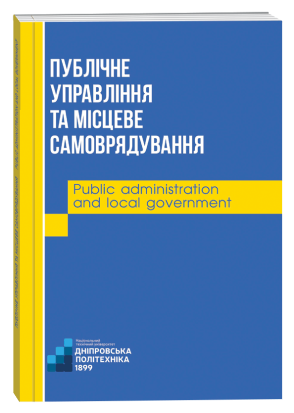SERVICE-ORIENTED ARCHITECTURE OF E-GOVERNMENT: CHARACTERISTICS OF THE ANGLO-AMERICAN MODEL AND PECULIARITIES OF ITS IMPLEMENTATION IN UKRAINE
DOI:
https://doi.org/10.33287/102066Keywords:
e-government, e-governance, service-oriented architecture of e-government, Anglo- American model of state informatization, needs of citizens, information technologiesAbstract
In the paper the advantages of the service-oriented architecture of e-government and its prospects for Ukraine are revealed. Service-oriented e-government is governed by a service-oriented architecture. Service- oriented architecture is the functionality of software as services aiming to establish compatibility in their provision. The model ofservice-oriented e-government architecture is divided into five layers (levels), arranged from bottom to top: operational level, semantic level, service level, process level, presentation level. The practice of service-oriented e-government in foreign countries is studies: USA, Canada, and Great Britain. These countries implement the so-called Anglo-American model of informatization of the state, which is based on: removal of redundant functions of government, delivery of public services to citizens, meeting the needs of citizens through information technology. This model promotes the development of transactions, payment for services via the Internet. Foreign experience shows that a key feature of government activities is to ensure the success of the implemented actions, as well as to control the quality and scope of services. Therefore, when developing e-government projects, the governments take their efforts to get the corresponding positive consequences in the availability of services: providing quality services to citizens and businesses; increasing revenues; easing the financial burden on federal and local governments, primarily by reducing documents and electronic services on the Internet. The trends of the model implementation in Ukraine are studies. The evolution of the issue included the Program «Electronic Ukraine», the realization of the E-Government Information System. The further steps are analyzed based on the information from the official website of the Ministry of Digital Transformation of Ukraine which provides the cases of service-oriented state (Popular services). The projects of the Ministry on Digital State digitize many services, update their legal framework, streamline the activity of state registers, and provide technical capabilities and data protection. It is concluded that service-oriented architecture of e-government is characterized by the features of its implementation based on such principles as: information-centric approach; the principle of a common platform, which focuses on creating an open information environment and common technological infrastructure for more effective collaboration of all participants and users of e- government; the principle of user orientation (all e-government activities are aimed at meeting the needs of service consumers); the principle of security and confidentiality.
References
Дмитренко В. І. Механізми впровадження електронного урядування на місцевому рівні: дис канд. наук з держ. упр.: 25.00.02. Київ, 2018. 248 с.
Карпенко О. В. Механізми формування та реалізації сервісно-орієнтованої державної політики в Україні: автореф. дис. … д-ра наук з держ. упр.: 25.00.02. Київ, 2016. 36 с.
Клімушин П. С., Спасібов Д. В. Концепція сервісно-орієнтованої держави в контексті модернізації публічного управління. Теорія та практика державного управління: зб. наук. пр. 2017. № 2(57). С. 21 – 28.
Міністерство цифрової трансформації України (Мінцифри). URL: https:// thedigital.gov.ua.
Про Загальнодержавну програму «Електронна Україна» на 2005 – 2012 роки: проект закону від 15 квіт. 2004 р. № 5414. URL: http://w1.c1.rada.gov.ua/pls/zweb2/ webproc4_2?id=&pf3516=5414&skl=5.
Про заходи щодо створення електронної інформаційної системи «Електронний Уряд»: Постанова Кабінету Міністрів України від 24 лют. 2003 р. № 208. URL: https:// www.kmu.gov.ua/npas/150472.
Рьсаев И. Ш., Гайнуллин А. Ю. Концепция «нового государственного управления» как основа трансформации государственного сектора: «за» и «против». Актуальнье проблемь развития системь государственного и муниципального управления: сборник научньх статей преподавателей, аспирантов и магистрантов / науч. ред. И. Ш. Рьсаев. Уфа: БАГСУ, 2013. 231 с.
Brannen, A. (2001). E-government in California: Providing services to citizens through the Internet. Spectrum, 74 (2), 6 – 10.
Davenport, T. H., & Short, J. E. (1990, July 15). The New Industrial Engineering: Information Technology and Business Process Redesign. Sloan Management Review, 31(4), 11 – 27. Retrieved from https://sloanreview.mit.edu/article/the-new-industrial-engineering- information-technology-and-business-process-redesign.
E-government. A strategic framework for public services in the information age. (2000). London: Breckland Print Solutions Ltd.
Emmanuel, C. L. (2008). e-Government Interoperability. United Nations Development Programme. URL: https://www.unapcict.org/sites/default/files/2019-01/e-Government% 20Interoperability%20-%20Guide.pdf
Erl, T. (2016). Service-Oriented Architecture: Analysis and Design for Services and Microservices. New Jersey: Prentice Hall.
Lee, Н., Lee, Y., & Yoo, D. (2000). The determinants of perceived service quality and its relationship with satisfaction. Journal of Services Marketing, 14(3), 217 – 231.
Machlup, F. (1992). The Production and Distribution of Knowledge in the United States. Princeton, New Jersey: Princeton University Press.
Rifkin, J. (2000). The Age of Access – The New Culture of Hypercapitalism. New York: Jeremy P. Tarcher/Putnam.
Sanati, F., Lu, J., & Zeng, X. (2007). A methodological framework for e-government service delivery integration. E-Government Interoperability Campus. Paris. Retrieved from https://www.researchgate.net/profile/Xianyi_Zeng/publication/228765304_A_Methodological_ F r a m ewor k_ for _ E - gove r n m e n t _S er vi ce _D el i ver y_ In t egr a t ion /l i n ks / 546cc1070cf26e95bc3ca3b6/A-Methodological-Framework-for-E-government-Service- Delivery-Integration.pdf.
Seifert, J. W. (2003). A primer on e-government: Sectors, stages, opportunities, and challenges of online governance. Report for Congress. Retrieved 28 January, 2003 from https://fas.org/sgp/crs/RL31057.pdf.
Seppanen, V. (2008). Interconnections and differences between EA and SOA in government ICT development. University of Jyvaskyla. Retrieved from https:// citeseerx.ist.psu.edu/viewdoc/download?doi=10.1.1.467.9777&rep=rep1&type=pdf.
The US government’s official web portal. (2014). Retrieved from http://www.usa.gov.






